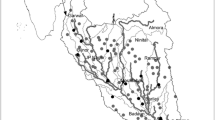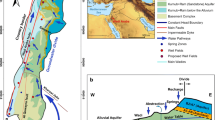Abstract
Aquifers are being threatened by overuse, and scenario predictions are convenient to design appropriate planning programs to water management. Numerical modeling is a helpful tool in these analyses, but it is hard to manage with limited data available, which is frequent in developing countries. The aim of the paper is to show that there are other simple and reliable options. The primary objective of this research is to propose and validate a simplified-to-available-data approach, useful for aquifer modeling, followed by scenarios’ simulation, based on realistic future events. The Mexican overexploited aquifer Cuautitlán–Pachuca case study assess the responses of the water level under different outflows and infiltration scenarios from 2007 (base year) to 2031. Modflow software allowed the model calibration with 2007 data, and further spatial and temporal evolution of the piezometric level. The aquifer is the main water supplier for economic activities, and population in the northern region of Mexico City and outflows are continuously increasing, despite its severe overexploitation and even stronger negative impacts in the decline water levels are predicted in this study. A previous study reported −194.97 hm3/year deficit in 2010, and this paper predicts the strongest effect due to overpumping caused by the population growth that would intensify the deficiency up to −236.29 hm3/year. The results have revealed to decision makers the urgency to prevent the aquifer’s irreversible impairment, with a proper operation and management planning. This paper provides a contribution for simplifying conceptual models allowing to predict aquifers’ outcome scenarios with limited data.








Similar content being viewed by others
References
Andreu J, Pulido A, Rodríguez Estrella T, García Sánchez E (2004) Investigaciones en sistemas kársticos españoles. Reference to a chapter in an edited book: Sobreexplotación de acuíferos kársticos Hidrogeología y Aguas Subterráneas. IGME. Spain, pp. 161–184. http://www.igme.es/igme/publica/lib3.htm http://aguas.igme.es/igme/publica/pdflib3/andreuro.pdf
Baalousha HM (2011) Modeling surface–groundwater interaction in the Ruataniwha basin, Hawke’s Bay, New Zealand. Environ Earth Sci 66(1):285–294. doi:10.1007/s12665-011-1238-y
Carrillo R JJ, Cardona A, Herat T, Huizar AR, Kobr M (1999) Marco geológico, hidrogeología subterránea, hidrogeoquímica, análisis geomorfológico y registros de temperatura en la subcuenca del río de las Avenidas. Informe Técnico. CAASIM, Hidalgo, México. 1:268
CEAA (2006) Estudio geohidrológico del Valle Pachuca-Tizayuca. Informe Técnico. Comisión Estatal del Agua y Alcantarillado, Hidalgo. Gobierno del Estado de Hidalgo., Hidalgo, Mexico
CEAA (2007) Estudio hidrogeológico del acuífero de Apan. Informe Técnico. Comisión Estatal del Agua y Alcantarillado, Hidalgo. Gobierno del Estado de Hidalgo., Hidalgo, Mexico
CEAA (2008) Integración geohidrológica de la Cuenca del Valle de México. Informe Técnico. Comisión Estatal del Agua y Alcantarillado, Hidalgo. Gobierno del Estado de Hidalgo., Hidalgo, Mexico
Cheng T, Mo Z, Shao J (2014) Accelerating groundwater flow simulation in MODFLOW using JASMIN-based parallel computing. Ground Water 52(2):194–205. doi:10.1111/gwat.12047
CONAGUA (2013) Estadísticas del Agua en México, Edición 2013. Secretaría de Medio Ambiente y Recursos Naturales, SEMARNAT. México, D.F. In: Naturales S.d.M.A.y.R. (ed.), México, pp. 165. http://www.conagua.gob.mx/CONAGUA07/Noticias/SGP-2-14Web.pdf
CONAGUA (2009a) Estadísticasdel agua de la región hidrológico-administrativa XIII, aguas del Valle de México. CONAGUA, pp 163. http://www.conagua.gob.mx/conagua07/noticias/ocavm-1-eaocavm2009.pdf
CONAGUA (2009b) Actualización de la disponibilidadde media anual agua subterránea. Acuífero (1508) Cuautitlán–Pachuca. Estado de México. Informe Técnico. In: Diario Oficial de la Federación el 28 de agosto de 2009, México. http://www.conagua.gob.mx/CONAGUA07/Noticias/DR_1508.pdf
CONAPO (2012) Delimitación de las Zonas Metropolitanas de México 2010. INEGI, Mexico, pp. 216. http://www.inegi.org.mx/Sistemas/multiarchivos/doc/702825003884/DZM20101.pdf
Conde ÁA, Gay GA (2008) Guía para la Generación de Escenarios de Cambio Climático a Escala Regional. Centro de Ciencias de la Atmosfera, UNAM. http://www.atmosfera.unam.mx/cclimat/Taller_CCA_INE_dic08/Guia_escenarios.pdf
Criterio (2014) PLATAH y el progreso. Politics 02-03. www.criteriohidalgo.com
Domenico PA, Schwartz FW (1998) Physical and chemical hydrogeology, vol 1. Wiley, London, p 502
Dragoni W, Mottola A, Cambi C (2013) Modeling the effects of pumping wells in spring management: the case of Scirca spring (Central Apennines, Italy). J Hydrol 493:115–123. doi:10.1016/j.jhydrol.2013.03.032
Esteller MV, Rodríguez R, Cardona A, Padilla-Sánchez L (2012) Evaluation of hydrochemical changes due to intensive aquifer exploitation: case studies from Mexico. Environ Monit Assess 184(9):5725–5741. doi:10.1007/s10661-011-2376-0
Fetter CW (2001) Applied hydrogeology, 4th edn. Prentice-Hall, New Jersey, p 598
Freeze RA, Cherry JA (1979) Groundwater. Prentice-Hall, New Jersey, p 604
Galindo Castillo E, Otazo Sanchez EM, Reyes Gutiérrez R, Arellano Islas S, Gordillo Martínez A, González Ramírez CA (2010) Balance hídrico en el acuífero Cuautitlán–Pachuca, México: Proyecciones para 2021. GEOFOCUS. (10):65–90. http://geofocus.rediris.es/2010/Informe5_2010.pdf
Hernández-García G, Huizar-Alvarez R (2003) Groundwater abstraction in the Zumpango-Pachuca region, central Mexico, and its environmental effects. Mater Geoenviron, 50:141–144. (And references therein). http://www.rmz-mg.com/letniki/rmz50/rmz50_0141-0144.pdf
Hugman R, Stigter TY, Monteiro JP (2013) The importance of temporal scale when optimizing abstraction volumes for sustainable aquifer exploitation: a case study in semi-arid South Portugal. J Hydrol 490:1–10. doi:10.1016/j.jhydrol.2013.02.053
Huizar-Alvarez R (1999) Hidrogeologia de la subcuenca Apan-Tóchac, Estados de Hidalgo y Tlaxcala, México. Rev Mex Geol Sci 6(2):217–229. http://satori.geociencias.unam.mx/16-2/(9)Huizar.pdf
Huizar-Alvarez R, Hernández G, Carrillo-Martinez M, Carrillo-Rivera J, Hergt T, Ángeles G (2003) Geologic structure and groundwater flow in the Pachuca-Zumpango sub-basin, central Mexico. Environ Geol 43(4):385–399. doi:10.1007/s00254-002-0654-4
INECC (2013) Quinta Comunicacion Nacional ante la CMNUCC, pp 142–143. http://www2.inecc.gob.mx/publicaciones/download/685.pdf
INEGI (2010) Censo de población y Viviendas. (2010 National Survey) http://www.beta.inegi.org.mx/proyectos/ccpv/2010
Katpatal Y, Pophare A, Lamsoge B (2014) A groundwater flow model for overexploited basaltic aquifer and Bazada formation in India. Environ Earth Sci 72(11):4413–4425. doi:10.1007/s12665-014-3342-2
Langevin CD, Panday S (2012) Future of groundwater modeling. Ground Water 50(3):334–339. doi:10.1111/j.1745-6584.2012.00937.x
McDonald MG, Harbaugh AW (1988) A modular three-dimensional finite-difference ground-water flow model: techniques of water-resources investigations of the United States geological survey, Book 6, Chapter A1. http://pubs.er.usgs.gov/publication/twri06A1
Medellín-Azuara J, Harou JJ, Olivares MA, Madani K, Lund JR, Howitt R, Tanaka ST, Jenkins MW, Zhu T (2008) Adaptability and adaptations of California’s water supply system to dry climate warming. Clim Change 87(1):75–90. doi:10.1007/s10584-007-9355-z
Neri Ramírez E, Rubiños Panta JE, Palacios Velez OL, Oropeza Mota JL, Flores Magdaleno H, Ocampo Fletes I (2013) Evaluación de la sustentabilidad del acuÍfero Cuautitlán–Pachuca mediante el uso de la metodología Mesmis Revista Chapingo Serie Ciencias Forestales y del Ambiente XIX:273–285. http://dx.doi.org/10.5154/r.rchscfa.2011.11.086
Otazo-Sanchez EM et al. (2013) PROGRAMA ESTATAL DE ACCIÓN ANTE EL CAMBIO CLIMÁTICO DE HIDALGO. Ed. Gobierno del Estado de Hidalgo-UAEH. Pachuca, HGO, Mexico. http://s-medioambiente.hidalgo.gob.mx/descargables/PEACCH.pdf
Sanders L (1998) A manual of field hydrogeology. Prentice-Hall, New Jersey, p 381
Salazar R, Szidarovszky F, Rojano A (2010) Water distribution scenarios in the Mexican Valley. Water Resour Manag 24(12):2959–2970. doi:10.1007/s11269-010-9589-9
Salcedo S, Edith R, Esteller MV, Garrido Hoyos SE, Martínez-Morales M (2013) Groundwater optimization model for sustainable management of the Valley of Puebla aquifer, Mexico. Environ Earth Sci 70(1):337–351. doi:10.1007/s12665-012-2131-z
SGM Servicio Geológico Mexicano (1997) Carta Geológico-Minera Pachuca F14-11, Hidalgo, Querétaro, Estado de México, Veracruz, Puebla, Esc. 1:250,000. http://www.coremisgm.gob.mx/productos/cartas/cartas250/geologia/metadatos/pachuca.html
SHCP Secretaria de Hacienda y Crédito Público (1969) Proyecto Texcoco. Memoria de los trabajos realizados y conclusiones. Informe Técnico. Fiduciaria Nacional Financiera S.A., Mexico
Smith L, Weathcraft SJ (1993) Groundwater Flow. In: Maidment DR (ed) Handbook of hydrology. McGraw Hill, Newyork
Sophocleous M (2005) Groundwater recharge and sustainability in the High Plains aquifer in Kansas, USA. Hydrogeol J 13(2):351–365. doi:10.1007/s10040-004-0385-6
SPDR-SDM (2011) Programa de Desarrollo Urbano y Ordenamiento Territorial de la Zona Metropolitana del Valle de Tizayuca [Urban Development and Territorial Planning Program for the Tizayuca Valley Metropolitan Zone], Hidalgo. http://www.tizayuca.gob.mx/Transparencia/IMDUyV/Articulo70/IncisoF/ORDENAMIENTOTERRITORIAL/PLANMAESTRODESARROLLOMETROPOLITANOVALLEDETIZAYUCA.pdf
THORSA (1991) Actualización Geohidrológica en el Valle de Pachuca-Tizayuca, Estado de Hidalgo. Ingenieros Consultores y Constructores S.A. de C.V., Mexico
USGS (2010) United States Geological Survey. Gorundwater Information. https://water.usgs.gov/ogw/MODFLOW_list_of_reports.html
Van Camp M, Walraevens K (2008) Recovery scenarios for deep over-exploited aquifers with limited recharge: methodology and application to an aquifer in Belgium. Environ Geol 56:1505–1516. doi:10.1007/s00254-008-1248-6
Yang Y et al (2011) Influence of South to North Water Transfer on groundwater dynamic change in Beijing plain. Environ Earth Sci 65(4):1323–1331. doi:10.1007/s12665-011-1381-5
Zektser S, Loáiciga HA, Wolf JT (2005) Environmental impacts of groundwater overdraft: selected case studies in the southwestern United States. Geol J 47(3):396–404. doi:10.1007/s00254-004-1164-3
Acknowledgements
Authors thank Hidalgo State Commission for Water and Sewage System (CEAA) for supporting this work in the framework of the Priority Program “Hydric Project for Hidalgo State.” We also thank the Regional Agency for Mexico Valley Waters from Water National Commission (GRAVAMEX). EGC and AEMC thank CONACYT and Hidalgo State University for his doctoral thesis scholarship and postdoctoral stage, respectively. The achieved data are listed in the References and Supplementary Information.
Author information
Authors and Affiliations
Corresponding author
Electronic supplementary material
Below is the link to the electronic supplementary material.
Rights and permissions
About this article
Cite this article
Galindo-Castillo, E., Marín-Celestino, A.E., Otazo-Sánchez, E.M. et al. Modeling the groundwater response to megacity expansion demand and climate change. Case study: the Cuautitlán–Pachuca aquifer, in the Northeast of Mexico City. Environ Earth Sci 76, 510 (2017). https://doi.org/10.1007/s12665-017-6808-1
Received:
Accepted:
Published:
DOI: https://doi.org/10.1007/s12665-017-6808-1




